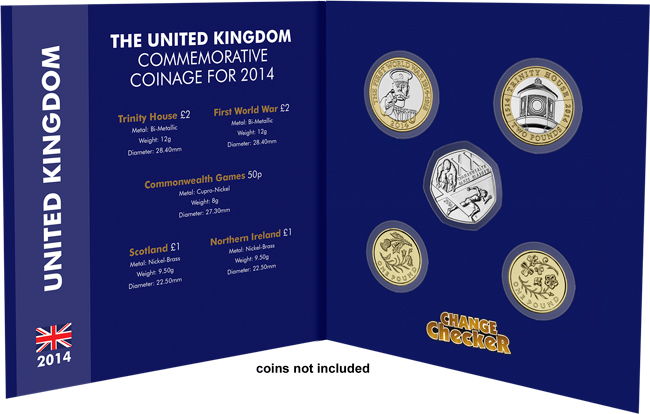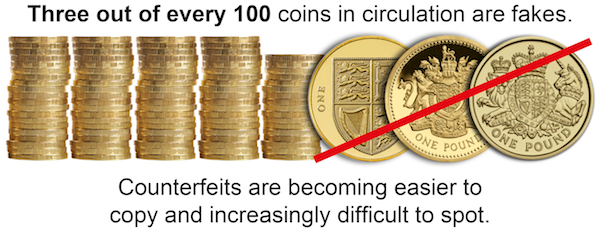£1 Coins
Royal Mint announce new coins for 2014…
The new UK coins for 2014 have been revealed, and are set to enter circulation this year. Here we take a closer look at the themes behind them, and why 2014 is another significant year for the coinage of the United Kingdom.
£2 – The First World War
2014 will of course be the 100th anniversary of the start of the First World War, and the Royal Mint has committed to a five-year commemoration of the emotive wartime journey from outbreak to armistice. It starts with a £2 coin bearing sculptor John Bergdahl’s depiction of Lord Kitchener’s unmistakable call to arms. The image of the British Secretary of War and his finger pointing at the reader still evokes an enormous sense of British identity and pride, and the coin also features the immortal words YOUR COUNTRY NEEDS YOU.
£2 – Trinity House
Since being granted a Royal Charter in 1514 by Henry VIII, Trinity House has safeguarded the coastal waters of Britain for over 500 years. Maritime safety became crucial in the 16th Century as Britain began flexing its naval strength overseas. And today, with 95% of the UK’s imports still arriving by sea, the Trinity House pilot ships and lighthouses are still as important today as ever. The reverse design of this new £2 coin features a striking depiction of a lighthouse lens – an enduring symbol of the the safety which Trinity House still provides at sea.
50p – Commonwealth Games
In 1986 the Commonwealth Games were held in Edinburgh, and the £2 of that year became the first coin in British history to commemorate a sporting event. Now, as Scotland gears up for the Games again in 2014, a new 50p to mark the occasion has been announced. The 20th Commonwealth Games will see thousands of athletes competing in 17 sports across 11 days in Glasgow. In this new reverse design, two of the most iconic sports – athletics and cycling – have been combined with a section of the St Andrews cross.
2013 saw the start of a £1 coin series celebrating the floral emblems of the British Isles designed by Timothy Noad. Completing the series in 2014 is the flax plant and shamrock to represent Northern Ireland, whilst the thistle and bluebell are portrayed on the Scottish version.
You can now collect all five designs straight from your change with the FREE Change Checker 2014 Coin Collecting Pack.
Do you remember the £1 note?
In 1984 it was announced the English £1 note would be completely phased out.
It’s now been 30 years since the humble £1 banknote ceased to be legal tender, having been gradually replaced by the £1 coin and fully removed from circulation in 1988.
To remember this lost gem from the 80’s, we’ve put together 10 facts about our banknotes and coins;
1) The pound note was replaced by the pound coin and officially withdrawn from circulation in 1988.
2) Prime Minister Margaret Thatcher was sceptical about the new coin which was first issued in 1983. She told MPs it was “not very popular” and believed the pound note would be retained.
3) The Royal Mint justified the logic behind replacing the £1 note with a coin: “The £1 note was in constant use on average lasting only nine months, whereas a coin can last as long as forty years and with the growth in the vending industry it was felt that a coin would be more useful.”
4) The first £10 note was issued in 1759 in response to gold shortages caused by the Seven Years War. The first £5 notes followed in 1793.
5) Five pounds was the lowest denomination in note form until 1797, when a series of runs on the Bank of England led to it issuing £1 and £2 notes.
6) Cashiers previously had the pain-staking task of filling in the name of the payee and signing each bank note individually. They were relieved of this duty after the first fully printed notes appeared in 1853.
7) Bank notes come in different ascending sizes, so the £5 note is smaller than the £10 which is smaller than the £20.
8) The withdrawal of the pound note in the 1980s was the biggest change to our currency since decimalisation in 1971.
9) The first £2 coin was issued in 1986 to commemorate the 13th Commonwealth Games being held in Scotland. The coin was not in general circulation until 1998.
10) The highest value note in circulation is £50. The most recent version is the first banknote to feature two Britons on the back – James Watt and Matthew Boulton.
Own the Last English £1 Banknote
This £1 Banknote features the signature of the Chief Cashier at the time, D H F Somerset, and a portrait of Her Majesty Queen Elizabeth II.
Could you spot a fake £1 coin?
One Pound coins were first issued in 1983, but one in every thirty £1 coins is now a fake. These forgeries cost the Government £2million every year.
Counterfeits £1 coins are becoming easier to copy and harder to spot which is why The Royal Mint have decided to issue a brand new 12-sided £1 coin which is billed to become the most secure circulating coin in the world.
The new 12-sided £1 coin will be an ultra-secure replacement which will be harder for forgers to copy. They will also last 5 years longer than the current round pound coins.
The figure of counterfeit coins has more than doubled in the past decade, and shockingly now three out of every 100 coins in circulation are fakes.
Counterfeits are becoming a closer match to the real thing, making it increasingly difficult for consumers to spot the difference. Usually, the only way you would notice a fake is if it were rejected from a vending or ticket machine.
The majority of coins are stamped out, which involves pressing a piece of metal against a specially cut die. However they can differ from the genuine article in many ways.
Here are a few tell-tale signs to look out for;
Appearance
The coin has been circulating for a long time according to its date of issue, yet it appears surprisingly new. Genuine pound coins lose their lustre when they have been in circulation for a number of years. Also fake coins tend to be more yellow or golden than the real thing.
Design
The design on the reverse doesn’t match the official design for the year it was issued – you can find all these designs on the Change Checker website. The first was introduced in 1983 and the reverse design has changed every year since.
Edge lettering
The lettering or inscription on the edge of a genuine £1 coin must correspond with the year date. Often the milled edge on counterfeits isn’t well defined and the lettering is uneven, badly spaced or indistinct.
Alignment
Hold the coin so that the Queen’s head is upright and facing you – the design on the reverse side should also be upright and not at an angle.
Unlike notes, coins are not usually banked, but instead circulate between the till and the customer’s pocket and back again which makes them more difficult to remove from circulation. The probability is that you have already used a counterfeit £1 coin as payment for something without realising, such is the quality of the fakes.
Remember, a fake £1 coin is not only absolutely worthless but it’s also illegal to pass it on to anyone else.
All the more reason to be regularly checking your change…









